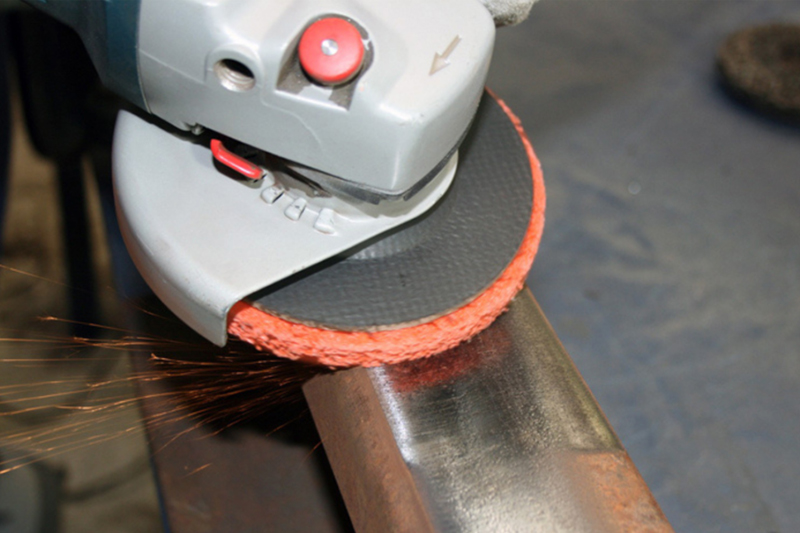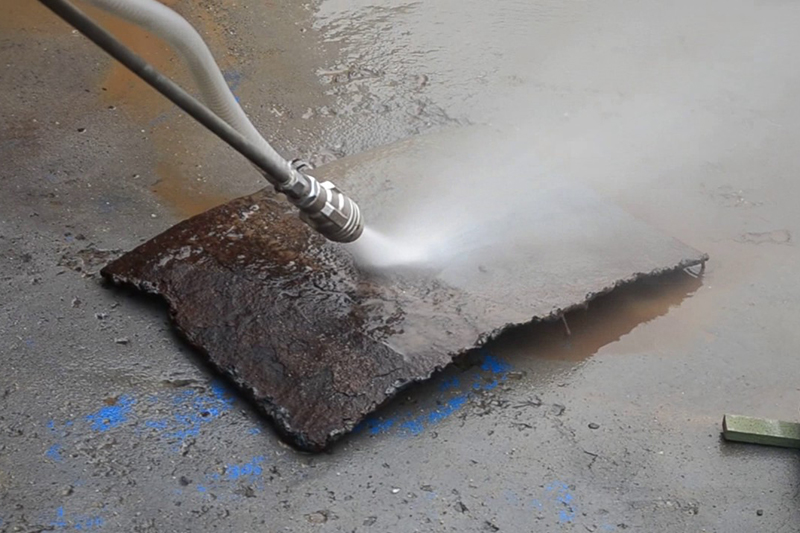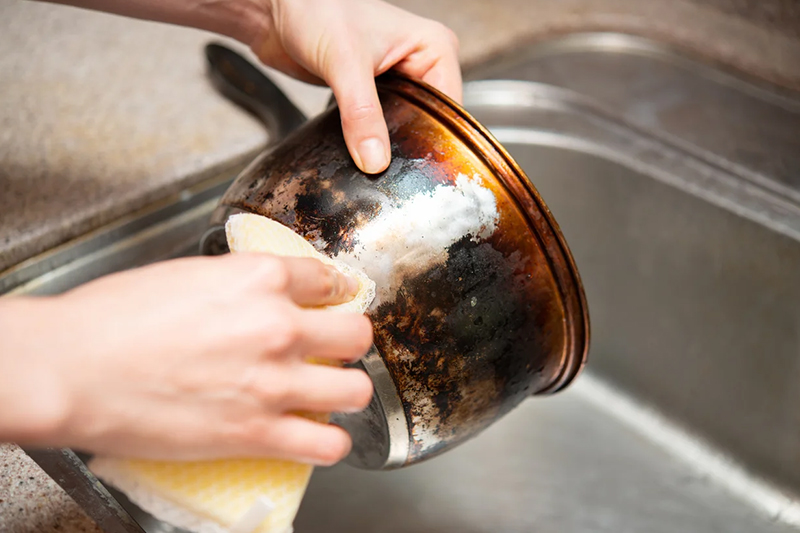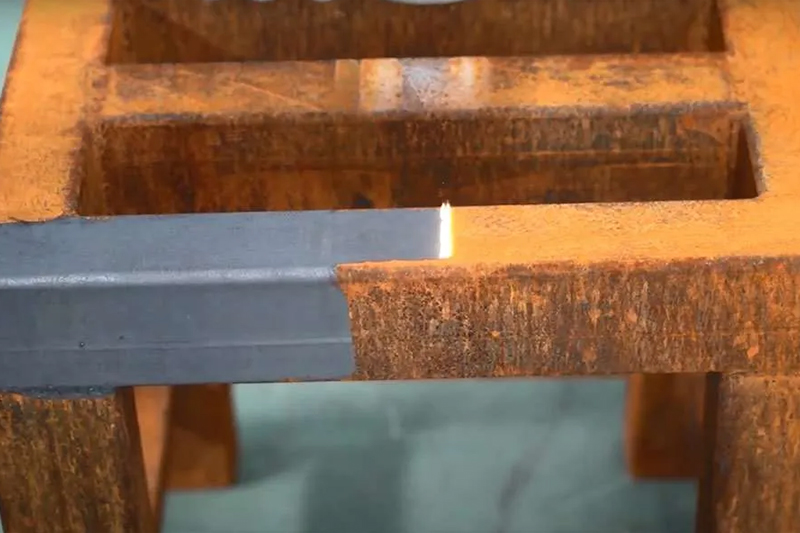Laser Rust Removal
Laser rust removal is an efficient physical rust removal method that uses laser beams to remove oxides and dirt from metal surfaces. This method is precise, non-destructive and efficient.
The principle of laser rust removal is to use laser energy to absorb and convert the rust layer into heat energy, thereby evaporating or peeling off the rust layer. This process, called photothermal action, can quickly and accurately remove oxides and dirt from metal surfaces while maintaining the integrity of the metal surface.
Physical Ways to Remove Metal Rust
Scrubbing rust removal: Use abrasive tools such as sandpaper, wire brushes, steel wool, or abrasive wheels to remove rust from metal surfaces. This method works on minor rust and requires patience and some strength.
Sanding rust removal: For more severe rust, a grinder or other sanding device may be necessary. This method is suitable for large areas or deep rust, but needs to be carefully controlled to avoid excessive wear on the metal surface.
 Ultrasonic rust removal:
Ultrasonic rust removal: Ultrasonic rust removal uses high-frequency sound waves to vibrate tiny bubbles in the liquid, causing severe local impact to remove dirt and rust from the metal surface. This method is suitable for parts with complex shapes, but the equipment is relatively expensive.
Sandblasting rust removal: Sandblasting uses high-pressure air or water to blast an abrasive, such as sand or steel shot, to remove rust and dirt from metal surfaces. This is a quick and effective method, but requires specialized equipment and skills to operate, as well as attention to safety and protection of the surrounding environment.
 Electrolytic rust removal:
Electrolytic rust removal: Electrolytic rust removal uses the principle of electrolysis to energize the electrolyte solution to partially dissolve or migrate the corroded metal to another piece of metal. This requires some special equipment and technical knowledge, but works better for complex metal components.
Chemical Ways to Remove Metal Rust
Acidic Solution Rust Removal: Using an acidic solution (such as acetic acid, lemon juice, or a commercial rust remover) can dissolve the iron oxide on the metal surface. You can soak metal parts in acetic acid or lemon juice, or use a specialized acid-based rust removal product, following the instructions.
Pickling rust removal: Pickling is a method commonly used in industry that uses an acidic solution, such as hydrochloric acid or sulfuric acid, to soak metal to remove rust and deposits. This requires specialized equipment and operations and should be performed in the appropriate environment and conditions.
 Chemical rust removers:
Chemical rust removers: There are a variety of chemical rust removers available in stores that contain chemicals that dissolve iron oxide. When using these rust removers, follow the product instructions closely to ensure safe and effective rust removal.
Best Rust Remover for Metal
Handheld Laser Cleaning Mahcine to Remova Metal Rust
Features:
Portability: Lightweight and compact design for easy handling and maneuverability. Often equipped with a handle or ergonomic grip for comfortable use.
Laser Source: Utilizes laser technology, typically fiber lasers or solid-state lasers, for precise and controlled cleaning.
Power and Pulse Control: Adjustable power settings to accommodate different cleaning requirements. Pulse control for fine-tuning the laser's energy output.
Laser Head: Handheld devices often have a modular laser head that can be easily manipulated to reach various angles and surfaces.
Variable Focus: Adjustable focal length or focus depth to accommodate different surface shapes and contours.
Functions:
Surface Cleaning: Effectively removes rust, paint, oxide layers, grease, and other contaminants from metal, concrete, stone, or other surfaces.
Selective Cleaning: Allows for precise and selective cleaning without damaging the underlying material. Ideal for intricate or delicate parts.
Mobility and Accessibility: Enables cleaning in hard-to-reach or confined spaces where larger cleaning equipment might be impractical.
Environmentally Friendly: Minimizes the use of abrasive materials and chemicals, reducing waste and making it an environmentally friendly cleaning solution.
Versatility: Suitable for various applications, including industrial maintenance, restoration projects, and surface preparation for coating.
User-Friendly Interface: Intuitive controls and display interfaces make the handheld laser cleaning machine easy to operate.
Speed and Efficiency: Provides a relatively quick and efficient cleaning process, especially for smaller to medium-sized areas.
3 in 1 Laser Cleaning Mahcine to Remova Metal Rust
5 Advantages of Laser Rust Removal Machine
Precision: Laser rust removal is highly precise and allows for targeted rust removal without damaging the underlying metal. The laser can be adjusted to remove rust selectively without affecting the surrounding material, preserving intricate details or delicate surfaces.
Non-contact Method: Unlike some other rust removal techniques that involve physical abrasion or chemicals, laser rust removal is a non-contact method. This means there is no direct contact with the metal surface, reducing the risk of damage or deformation to the material.
 Environmentally Friendly:
Environmentally Friendly: Laser rust removal typically doesn’t involve the use of chemicals or abrasive materials that can generate waste or be harmful to the environment. It's a cleaner process that doesn't produce hazardous byproducts.
Efficiency: It's a relatively quick and efficient method for rust removal, especially for larger surfaces or intricate designs. The laser can cover a significant area relatively fast compared to manual methods, speeding up the restoration process.
Versatility: Laser rust removal machines are versatile and can be used on various types of metals, including steel, iron, aluminum, and more. They are also effective for removing rust from different surfaces, whether flat or contoured, making them suitable for a wide range of applications.
How to prevent metal from rusting?
Preventing metal from rusting involves various methods aimed at creating barriers between the metal surface and elements like moisture and oxygen, which contribute to the rusting process. Here are some effective ways to prevent metal from rusting.
Protective Coatings: Apply protective coatings like paint, enamel, or varnish to create a barrier between the metal surface and the surrounding environment. These coatings act as a shield against moisture and oxygen, preventing direct contact with the metal.
Galvanization: This process involves coating the metal with a layer of zinc, which provides sacrificial protection. Zinc corrodes before the underlying metal does, thereby preventing rust formation on the actual metal surface.
Plating and Anodizing: Electroplating the metal with chromium, nickel, or other metals forms a protective layer that resists corrosion. Anodizing aluminum creates a protective oxide layer on its surface, preventing rust.
Keep it Dry: Rust forms in the presence of moisture, so keeping metal surfaces dry helps prevent rusting. Wipe off excess moisture, and store metal items in a dry environment or use dehumidifiers in storage areas.
Use Desiccants or Anti-Rust Products: Store metal items with desiccants like silica gel packets or use anti-rust products that create a protective film on the metal surface.
Regular Maintenance: Inspect metal surfaces regularly for signs of rust or damage. Clean and repair any scratches or chips in protective coatings promptly to prevent rust from forming.
Proper Storage: Store metal items properly by keeping them away from harsh environmental conditions, direct exposure to rain, or salty air, especially for outdoor metal structures or equipment.
Avoiding Scratches and Abrasions: Preventing scratches or abrasions on the metal surface helps maintain the integrity of protective coatings, reducing the chances of rust formation.
Each method has its advantages depending on the type of metal, its use, and the environmental conditions it's exposed to. Combining multiple preventive measures often offers the best protection against rust for metal objects.
Conclusion
In conclusion, effectively removing metal rust is essential for maintaining the integrity and aesthetics of metal surfaces. The best approach to removing metal rust may vary depending on factors such as the extent of rust damage, the type of metal involved, and personal preferences. However, by leveraging the diverse range of methods and techniques outlined in this guide, individuals can confidently address rust issues and ensure their metal surfaces remain in optimal condition.




